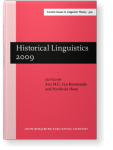Ethnicity as an independent factor of language variation across space
Trends in morphosyntactic patterns in spoken Afrikaans
Gerald Stell | Research Foundation Flanders (FWO), Free University of Brussels, Belgium
Social class and its affiliated indicators such as geographical mobility and strength of network ties have been treated as prominent, if not overarching variables in sociolinguistic research on spatial diffusion of linguistic features. There are nonetheless grounds, in the light of linguistic data on the Black and White divide in the U.S, for regarding ethnicity as a factor of language variation across space operating independently of these variables in certain defined contexts. A point of comparison for the linguistic Black and White divide in the U.S. is found in the Afrikaans speech community, i.e. a bi-ethnic community composed of Whites and Coloureds, who generally form socio-economically distinct networks. This contribution is based on an ethnically representative corpus of spoken Afrikaans involving three age cohorts. Its purpose is to reveal how far membership of the White or Coloured community determines grammatical variation across the Afrikaans language area.
The Milroys (1985) have shown that strength or weakness of social network ties have become a determining factor in language variation while historical patterns of geographic differentiation have, most especially in highly mobile societies, often lost much of their relevance (see further Milroy 2002; Britain 2002). The multiethnic character of certain societies does however raise the question whether ethnicity leaves its imprint on language variation regardless of strength or weakness of social network ties. This question seems warranted in the light of Fought’s observation that “[e]ven where, on the surface, extensive interethnic contact and integration seem to be the norm, the study of linguistic variation reveals the underlying preservation of identities divided along ethnic lines” (2002: 452).
A question, originally raised in the U.S. and as yet unanswered, is how far such identities divided along ethnic lines are preserved across space within the same speech community. This question has been posed repeatedly in reference to the relationship between African American Vernacular English (AAVE) and Anglo varieties. It became particularly topical in the wake of the momentous, yet controversial finding by Labov & Harris (1986) that Black and White vernaculars are not only systematically different, but also diverging countrywide.
South Africa and Namibia’s Afrikaans speech community is a mainly bi-ethnic community composed of roughly equal proportions of Whites and Coloureds, who generally form socio-economically distinct networks. Afrikaans dialectology or variation studies never attempted to chart variation in Afrikaans in terms of both Coloured and White varieties, one notable exception being Klopper’s research on urban Cape Afrikaans (Klopper 1983). The questions I want to ask here is whether there may be a question of a Coloured Afrikaans and of a White Afrikaans, and, if so, how the relationship between these two varieties can be described across space.
This contribution is based on an ethnically representative corpus of spoken Afrikaans aimed to give a picture of apparent-time trends in language variation over the main Afrikaans historical dialect zones as well as across the urban/rural divide. Trends will be illustrated using a range of Afrikaans morphosyntactic variables, against which predictions based on variationist postulates and local sociological data will be tested. We will finally discuss whether our findings on ethnic variation in Afrikaans speak in favour of treating ethnicity as a possible independent factor of variation.
In the first paragraph we will briefly introduce Afrikaans against Southern Africa’s multiethnic background. This is followed by an overview of findings on the relationship between ethnicity, space and other social factors in language variation. After a presentation of the corpus and the selected morphosyntactic variables, the ethnic factor will be tested against similarities and differences across age cohorts between a range of geographically defined White and Coloured samples.
Cited by (1)
Cited by one other publication
This list is based on CrossRef data as of 23 july 2024. Please note that it may not be complete. Sources presented here have been supplied by the respective publishers.
Any errors therein should be reported to them.
